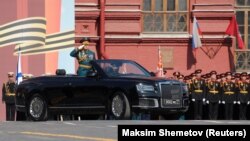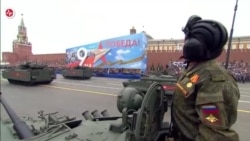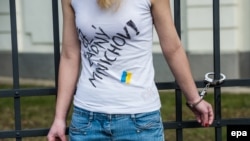On May 8, the eve of Russia’s commemoration of the 74th anniversary of Nazi Germany’s surrender in World War II, Russian Foreign Minister Sergei Lavrov responded to what he characterized as accusations that Russia’s celebration of the event constitutes “militarizing public opinion.” He claimed that “some countries would like to forget as soon as possible about the role they played in the years prior to World War II.”
Lavrov neither specified who had made such accusations nor the countries he accused of wanting to forget their pre-World War II roles. He was even less specific in his reference to “militarizing” public opinion, but we’ll tackle that subject lower in this story.
Polygraph.info video fact check by Nik Yarst.
Without knowing which countries Lavrov was referring to, it is not possible to specify which pre-war roles he had in mind. However, it is worth comparing how the period is treated in Russia and in other countries which fought in that war.
British students, for example, are taught about the failure of British Prime Minister Neville Chamberlain’s policy of appeasing Nazi Germany, which is generally blamed in the West for encouraging Hitler’s aggression. In the infamous Munich agreement, Chamberlain negotiated with Hitler to give away Czechoslovakia’s German-populated Sudetenland in exchange for an assurance of peace. The annexation left Czechoslovakia defenseless when Hitler occupied and dismantled that country in 1939, leaving the German military with a wealth of high quality weapons, particularly tanks and artillery. Thanks to Munich, the very name Chamberlain has becoming virtually synonymous with appeasing aggressors.
Soviet War Losses, Weakening Germany
First, it must be said that the Nazi war machine was largely destroyed thanks to Hitler’s decision to invade the Soviet Union. An estimated 75 percent of the German Wehrmacht, not counting Axis troops like those of Hungary, Italy, and Romania, were destroyed on the “Eastern Front," according to Red Army historian David M. Glantz in his book "WhenTitans Clashed: How the Red Army Stopped Hitler."
Equally staggering was the scale of the human suffering that the Soviet Union experienced as a result of the war, with estimates of Soviet dead ranging from 25-27 million. Entire countries like Belarus and Ukraine (then part of the Soviet Union) were occupied by Axis forces for several years, and some of the most infamous events of the Holocaust took place on Soviet territory.
Russian School Lessons: The Fact Check
What do Russian students learn about the Great Patriotic War, as they call World War II? Thanks to their state-approved curriculum, Russian pupils do not learn the full explanation for why Soviet losses were so high: the latest history text glosses over the pre-war atrocities of Soviet dictator Josef Stalin’s regime, including the purges that severely hampered the Red Army’s reorganization and preparation for war.
Absent from the curriculum in Russian schools is the full story of the so-called Molotov-Ribbentrop non-aggression pact that Nazi Germany and the USSR signed on August 23, 1939. After trying for several years to conclude a collective security agreement with Britain and France against Nazi Germany, the Soviet Union acquiesced to a German offer of a non-aggression pact. The Soviet Union was not the first country to sign such a pact with the Third Reich. One earlier example was Poland in 1934. The Soviet agreement, however, included a secret protocol that divided Central and Eastern Europe into two spheres of influence. Under this arrangement, after Germany invaded Poland on September 1, 1939, the Red Army invaded the eastern part of the country two weeks later. From that period until the German invasion of the Soviet Union on June 22, 1941, Stalin used the free hand granted by the secret protocol to annex and invade several countries, including Finland and the Baltic states.
A 2017 Moscow Times story said the most popular textbook’s latest edition “puts less emphasis on the secret protocols” and quotes a historian and teacher Leonid Katsva, who says the text “has a more justifying tone,” calling invasion by Soviet troops in Eastern Europe “liberation.”
After criticizing the Molotov-Ribbentrop pact while serving as Russia’s prime minister in 2009, President Vladimir Putin has since defended it on more than one occasion, stating that it gave Russia time to prepare for the war in lieu of an agreement with Britain and France. There is some historical support for this view, and the claim that the Soviet Union was not ready for war is similar to British defenses of Chamberlain’s appeasement policy. Still, Putin omitted key facts about the agreement. We get to that in a context section.
But if schools in Russia don’t teach the inconvenient facts, trying to correct the record can get one into trouble in Russia. In 2017, a man in the city of Perm was fined approximately $3,500 for reposting an article that mentioned the Soviet Union’s invasion of Poland in September 1939.
And so we find Lavrov comment that “some countries would like to forget” their pre-war roles to be misleading in leaving Russia’s amnesia out of the equation.
‘Militarizing’ Public Perceptions
Lavrov’s objection to accusations that Russia militarizes public opinion is not specific, and so cannot be fact checked.
Let’s look at the May 9 commemorations: Many Russians and people in neighboring countries complain that there is excessive celebration and commercialization of what they call Victory Day, which some say should be a far more solemn occasion given the enormous sacrifices the people of the Soviet Union made during the war. Russian-language (though not necessarily Russian nationality) social media accounts typically cite cases like the kindergarten which dressed its young pupils in various military uniforms this year. Russians have even come up with a word for this kind of behavior -- “pobedobesiye,” which roughly translates as “victory insanity.”
More recently, marches for the so-called “Immortal Regiment” organized by the Russian government and by Russian consulates around the world have been the target of criticism. These marches began in 2012 as part of a grassroots project featuring parades whose participants held placards with photos of their dead relatives who fought in the war.
The authorities subsequently hijacked this project and used it for pro-Kremlin themes. For example, a photo of an Immortal Regiment march in Italy that was tweeted by an official Russian account this May 8 showed a marcher waving the flag of the so-called “Donetsk People’s Republic,” one of the puppet pseudo-states set up by Russia in eastern Ukraine in 2014.
On more than one occasion, participants in the marches have carried pictures of Russian militia leaders in eastern Ukraine, such as Arsen “Motorola” Pavlov and Mikhail “Givi” Tolstykh, both of whom either were recorded or admitted to abusing Ukrainian POWs in 2014-2015. Neither had anything to do with World War II, which of course ended decades before they were born, but can be seen as modern symbols of military prowess.
Further Context on the Non-Aggression Pact
In the interest of fairly representing this complex history, there is value in looking deeper at the arguments. While the Soviet Union did buy time to arm itself, it also supplied the German war machine with vital raw materials, grain, and most importantly oil, for its campaigns, including the invasion of France and the Low Countries in 1940. Historian Edward Ericson argues in his book "Feeding the German Eagle: Soviet Economic Aid to Nazi Germany" that without the vital aid from the Soviet Union, Hitler would not have been able to invade that country, as Germany would have run out of several key resources by the spring of 1941. Although the Soviet Union received vital intelligence on German military technology, this benefit was significantly outweighed by what the Third Reich received from the Soviet Union in the form of economic aid.
Another argument in favor of the pact is that it gave the Soviet Union strategic depth by pushing the border westward, and that this was crucial once Hitler broke the pact and invaded in June 1941. This argument was even made by none other than British Prime Minister Winston Churchill in 1939:
“Russia has pursued a cold policy of self-interest,” Churchill said. “We could have wished that the Russian armies should be standing on their present lines as the friends of the allies in Poland, instead of as invaders. But that the Russian armies should stand on this line was clearly necessary for the safety of Russia against the Nazi menace.”
Setting aside moral questions about invading and annexing other nations simply to shore up one’s defense against invasion, historians have shown that this argument, at least in hindsight, is flawed. Prior to the signing of Molotov-Ribbentrop, the Soviet Union was engaged in building massive border defenses known as the Stalin Line. Once the border was pushed far to the west, much of this was either dismantled or left in disrepair as a new Molotov line of defense was begun along the new borders. This new defense line was not complete when Germany invaded in 1941, which contributed to the Germans’ massive gains during the first few months of the invasion. Also, the Red Army’s extremely poor performance against Finland in the so-called “Winter War” of 1939-1940 helped convince Hitler and German military leaders that the Soviet Union was weak and incapable of defending itself against an Axis onslaught.
[Editor's note: The photo of Molotov, with Stalin seen standing, (seen directly above) is a signing ceremony for a secret supplementary protocol that set the Lithuanian border. This supplement was inked nearly a month after the pact was agreed to, and 28 days after Germany commenced hostilities. A third secret protocol was signed in January 1941, also involving control of Lithuania. The caption in the file was not clear this was the second signing. We have clarified and corrected it. The body of the story correctly notes the original pact was signed August 23, 1939]











